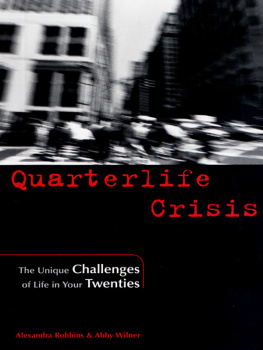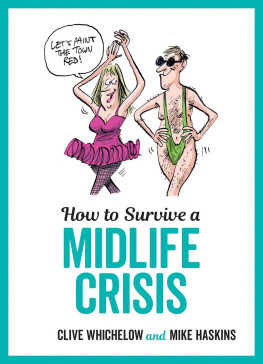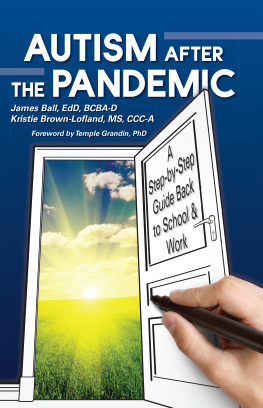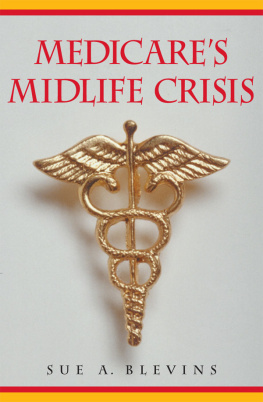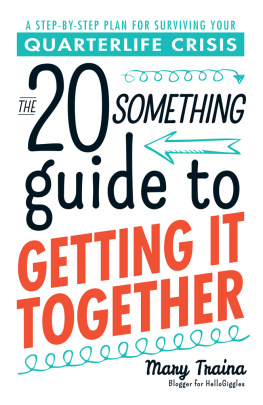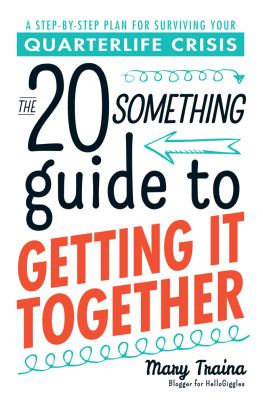*Throughout, some names and identifying details have been changed.
quarterlife CRISIS
Jeremy P. Tarcher / Putnam
a member of Penguin Putnam Inc.
New York
Alexandra Robbins
and Abby Wilner
The Unique Challenges of Life in Your Twenties
Most Tarcher/Putnam books are available at special quantity discounts for bulk purchase for sales promotions, premiums, fund-raising, and educational needs. Special books or book excerpts also can be created to fit specific needs. For details, write Putnam Special Markets, 375 Hudson Street, New York, NY 10014.
Jeremy P. Tarcher/Putnam a member of
Penguin Putnam Inc.
375 Hudson Street
New York, NY 10014
www.penguinputnam.com
Copyright 2001 by Alexandra Robbins and Abby Wilner
All rights reserved. This book, or parts thereof, may not be reproduced in any form without permission.
Published simultaneously in Canada
Library of Congress Cataloging-in-Publication Data
Robbins, Alexandra, date.
Quarterlife crisis: the unique challenges of life in your twenties / Alexandra Robbins and Abby Wilner.
p. cm.
Includes index.
ISBN: 978-1-1012-1586-9
1. AdulthoodPsychological aspects. 2. Young adultsConduct of life. 3. Young adultsPsychology. I. Wilner, Abby, date. II. Title.
BF724.5 .R55 2001 00-066760
158'.084'2dc21
Acknowledgments
A number of people made writing this book a pleasure. Thanks, first and foremost, to my parents for their patience and support, to my siblings for keeping me company and entertaining me during long nights at the computer, and to my grandparents for their enthusiasm.
I am also eternally grateful to David Dashefsky for everything, Amy Lindenbaum for being the best a friend can be, Joe Klein for his encouragement, Andrea Kirk for her help with sources, Nick Bernstein for cracking me up, the Upstarts for humoring me, and Abby Wilner for inspiring me.
This book would not have been written but for Dick Victory, who urged me to do it; Jane Mayer, who kindly went out of her way to jumpstart the process; and of course, Paula Balzer, who got it done patiently with a smile.
Finally, thanks to all of the twentysomethings who agreed to be interviewed for this book. You were honest, open, thoughtful, and articulate. You are the spokespersons for our generation.
A.R.
Acknowledgments
Special thanks to:
E&Efor bringing me into this world and making my quarterlife crisis possibleand for raising me to believe I could accomplish anything, even publish a book.
Amy Dowis for the original idea to write a book for troubled twentysomethings, and the League for inspiration, if you know what I mean.
Ellona, Tammy, and the friends who make me laugh, the runners who make me strong, and the neighbors of QHS11 who keep me companythanks to all of you who turned my QLC into the most fabulous time.
The pros I knowDr. Robert DuPont and Tony Pitchwho offered their expertise, believed in this book and encouraged me to make it happen.
Alex Robbins for dedicating yourself to the book and making my dream a reality.
Paula Balzer, of Sarah Lazin Books, and Jeremy P. Tarcher for taking a chance on us.
Finally, the hundred or so twentysomethings who made this book what it is by opening up and sharing their experiences. Thanks to you, people will realize just how common the quarterlife crisis really is. This huge transitionbecoming an adulthas been completely overlooked, until now.
A.W.
Contents
To Ira, Jo,
Andrew, Missy,
Rachel, Irving,
Seena and Marty,
with love
Preface
Our intention, when we first began to work on this book, was to get the idea of a quarterlife crisis into the national discourse. The more that people would use the term quarterlife crisis, in any fashion, the more twentysomethings would hear it, relate to it, and know their own experiences were both common and legitimate. When members of the book industry warned us that it might be difficult to market a book to twentysomethings, we resigned ourselves to accepting the fact that the book might help a few scattered twentysomethings across the country who might see themselves in some of the stories. We never expected what followed.
Quarterlife Crisis: The Unique Challenges of Life in Your Twenties sparked an international dialogue, with widespread discussions on the radio, in newspapers, and on TV. Our book has been published in countries as diverse as England, Korea, and Brazil. We have heard from hundreds of twentysomethings across the worldincluding peers in Zimbabwe, Malaysia, and Singaporemost of whom have expressed variations on the same theme: I thought I was alone.
We found this global phenomenon staggering: thousands, if not millions, of twentysomethings were experiencing similar identity issues, yet the vast majority of these young adults remained silent. Because the twenties are portrayed asand therefore are supposed to besuch a carefree, rollicking good time, few people were willing to admit that they werent actually having the time of their lives after all. Twentysomethings would get caught in a cycle:
- 1) They would be unhappy (or anxious or depressed).
- 2) They wouldnt talk about it.
- 3) Because they wouldnt discuss their problems, they wouldnt learn that these issues were common.
- 4) They thought something must be wrong with them individually.
- 5) Their self-doubt subsequently spiraled, and they became unhappier.
Luckily, this cycle is changing. It has become acceptable to talk about a quarterlife crisis with friends, at parties, in bars. New quarterlife crisis support groups are sprouting up around the nation specifically to allow twentysomethings to share their experiences with others, relate, and feel better. Young adults and recent graduates are learning now that the twentysomething years arent supposed to be a constant high but rather a journey full of both successes and setbacks.
We, too, have journeyed far over the past year, from harboring humble expectations to discovering that our peers are eager and excited to assist and encourage one another. We thank youreaders, writers, and listenersfor accompanying us on this journey.
The Authors
Spring
quarterlife CRISIS
introduction
What Is the Quarterlife Crisis?
J im, the neighbor who lives in the three-story colonial down the block, has recently turned 50. You know this because Jims wife threw him a surprise party about a month ago. You also know this because, since then, Jim has dyed his hair blond, purchased a leather bomber jacket, traded in his Chevy Suburban for a sleek Miata, and ditched the wife for a girlfriend half her size and age.
Yet, aside from the local ladies groups sympathetic clucks for the scorned wife, few neighbors are surprised at Jims instant lifestyle change. Instead, they nod their heads understandingly. Oh, Jim, they say. Hes just going through a midlife crisis. Everyone goes through it. Friends, colleagues, and family members excuse his weird behavior as an inevitable effect of reaching this particular stage of life. Like millions of other middle-aged people, Jim has reached a period during which he believes he must ponder the direction of his lifeand then alter it.
Chances are, if youre reading this book, youre not Jim. You know this because you cant afford a leather bomber jacket, you drive your parents Volvo (if you drive a car at all), and, regardless of your gender, you would happily marry Jims wife if she gets to keep the house. But Jims midlife crisis is relevant to you nonetheless, because it is currently the only age-related crisis that is widely recognized as a common, inevitable part of life. This is pertinent because, despite all of the attention lavished on the midlife crisis, despite the hundreds of books, movies, and magazine articles dedicated to explaining the sometimes traumatic transition through middle age and the ways to cope with it, the midlife crisis is not the only age-related crisis that we experience. As Yoda whispered to Luke Skywalker, There is another.

